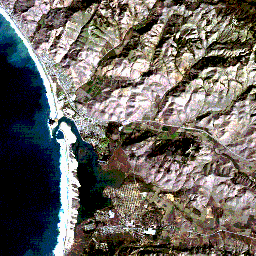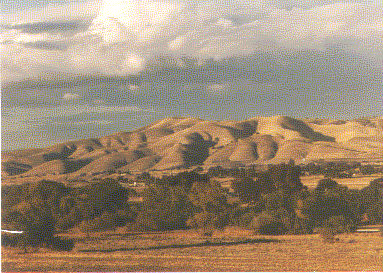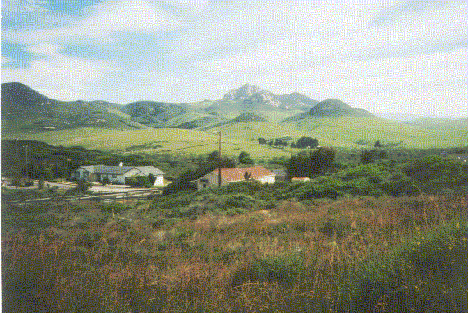
In practice, various color mapping algorithms are used to facilitate visual interpretation of an image, while analytical treatment usually works with the original DN (digital numbers) values of the pixels. The original DN values contain all of the information in the scene and though the range of values they take on may make it necessary to remap them to create a good display, no information is added. In fact, although visual interpretation is easier with the remapped image, information has been lost and distorted, thus the use of the original DN values or DN values translated to calibrated radiances in analytical work.
With this mapping, the result is a pleasing and satisfying image because it depicts the world as seen from above in the general color ranges with which we are naturally familiar. Try to imagine how this scene would appear to you if you were flying over it from a high airplane.
You would likely comment that the ocean appears too dark in the Idrisi TM composite. This is due to its general darkness of all the bands - the consequence of water's ability to absorb light over most of the visible range and, to a lesser degree, to the algorithm that Idrisi uses to combine three 8 bit bands into a single 8 bit composite image. The only exception is, of course, related to the breakers (here, with little internal structure) that are highly efficient at scattering light. The sediment patterns that we noted vary through bands 1 to 3 are clearly separable (rather than gradational) in this color rendition with areas of greater load density having some green input (band 3 [red] shows only the densest sediment areas). Note especially the dark brownish- green tones just off the delta where the coastal marsh develops, interpreted as the expression of a heavy load dumped at the mouth of the small river (p) flowing over it.
Probably the most unrealistic color in the rendering of the Idrisi version of this "true color" scene is allied to the bright hill slopes. In this rendition, the base color is tan with some purplish overtones but there are small areas and patches marked by a darker brown tone which if inspected at ground level would have some green tints. The color composite shows these surfaces in a somewhat misleading way. From an airplane, you might describe these surfaces as a light golden-brown (from the dry grass, one reason California is often called the "Golden State"), similar to the terrain shown below which matches the view of the first version's color mapping more closely.

The reason for the red-brown-purple color is that light from surfaces at certain orientations will contribute considerable red from band 3, some blue (hence purple) from band 1, and little green from band 2.
The areas we've presumed to be active grasslands (v) appear in "true color" as a slightly reddish brown. Areas correlated with fields and meadows are a medium brown. Most areas that were associated with medium to dark reds in the false color composite are very dark in the natural color version. This is particularly valid for the National Forest growth around (u) and the stream-lining vegetation (i) and wooded patches (l) scattered throughout the scene. The diminution of green color is explainable as follows: most of this vegetation is either California oaks, which have dark green leaves, or perhaps also some other evergreens which tend to be less reflective than deciduous plants, thus the dark brown color. These leaves, or needles, have generally lower reflectance in all bands 1-3 but still are proficient reflectors (from cell walls) in band 4.
The coastal marsh (o) shows up as a dark brownish-red in this true color rendering (as it seems to do in the aerial oblique photo). At least part of this effect may link to types of vegetation similar to that in the foreground of this photo introduced earlier which shows the edge of the marsh area well after the rainy season has started.

In this natural color version, the mystery feature at s is displayed in its "full glory", being a collage of bright green arranged roughly in elongate strips. If you haven't fathomed its identification already, let it now be revealed that it is an 18-hole golf course. We have extracted the portion of the digitized aerial oblique photo, that contains this tract, known as the Morro Bay Golf Course on State Park Road, showing close-up the lighter green fairways midst darker green trees. The two bright patches within might even be sand traps. (Their seemingly overblown size in the photo is misleading, in that even if they are actually smaller than the 30 m resolution of a TM pixel containing a trap, the great brightness each contributes will nevertheless swamp the reflectance response of other classes in that pixel, making it appear overly light in tone; this same phenomenon was observed early in the Landsat program where small [less than 8 m {26 ft} wide] dirt roads passing through sage brush or grasslands could be resolved because the pixels containing these pathways were substantially brightened.)
There are several parts of the image that contain distinctive orange-brown tones, as at x. This is apparently a manifestation of soils that have a richer brown color. This can also be noted in the valley north and east of Los Osos and in part of that town itself. This valley appears to have its own small stream (but not easily resolvable) or perhaps once had a larger stream now gone. Such a valley likely is underlain by alluvial deposits that typically also are browner (enhanced by hydrous iron oxides similar to rust in composition).
Code 935, Goddard Space Flight Center, NASA
Written by: Nicholas M. Short, Sr. email: nmshort@epix.net
and
Jon Robinson email: Jon.W.Robinson.1@gsfc.nasa.gov
Webmaster: Bill Dickinson Jr. email: rstwebmaster@gsti.com
Web Production: Christiane Robinson, Terri Ho and Nannette Fekete
Updated: 1999.03.15.